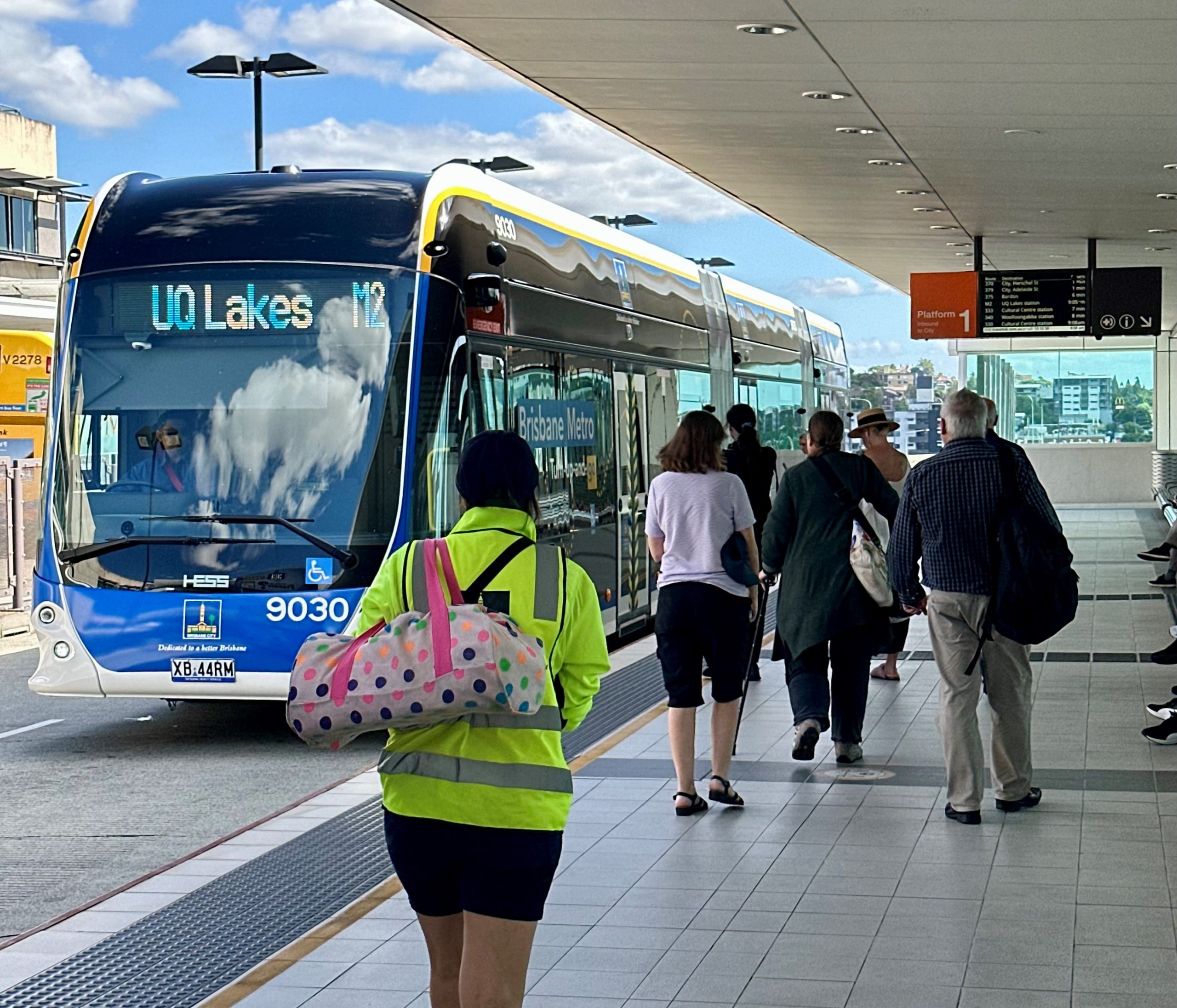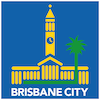
Brisbane Metro bus rapid transit has permanently arrived in Brisbane today with the fully-electric services now running between the Royal Brisbane and Women’s Hospital (above) and the University of Queensland (UQ Lakes).
This commencement of Brisbane Metro brings the biggest evolution to the bus network in decades, with M2 services boosting capacity by up to 3.4 million seats a year.
The M2 from RBWH to UQ will run at five-minute peak frequencies and service 12 stops, including two universities, three hospitals, the Cultural Centre, and CBD.
Each fully-electric vehicle is 24.4 metres long, can carry up to 170 passengers and will be named after something unique to Brisbane, with the first vehicle named after NRL legend Darren Lockyer.
The launch of permanent services follows the successful 169 preview which achieved a 94 per cent on-time running and a 4.3 out of 5 customer satisfaction rating.
Today also marks the start of staged implementation of Brisbane’s New Bus Network, including:
- M2 permanently replacing route 66
- Nine new school services introduced, and two under-utilised routes removed
- Temporary Route 86 loop finishes services
- Seven routes permanently moved from CBD busway stations to street level (Routes 425, P426, 430, 431, 435, P443, and 446)
- Route 444 moved back to stop 1A (from 1C) in City Hall/King George Square station
- At UQ Lakes, Routes 139 and Route 169 will be relocated from Stop B to Stop D.
Passengers on board Metro will receive real-time travel information voiced by Brisbane-born actress Melanie Zanetti who voice went global for her role in kids show Bluey.
The real-time stop announcements will currently include the dual naming of City Hall / King George Square ahead of its permanent transition to ‘City Hall’ station.
The renaming of King George Square station to City Hall station will make it easier for Brisbane residents and visitors to navigate the bus network.
The name better reflects the station’s close proximity to key Brisbane landmark City Hall and aligns with naming conventions of other Australian and international metropolitan cities.
The staged implementation of Brisbane Metro:
Today – (Tuesday, 28 January):
Ø Brisbane Metro starts service on Brisbane’s most in-demand bus route, converting the Route 66 bus service into the permanent “M2” Brisbane Metro service, running at five-minute peak frequencies between RBWH and UQ Lakes.
- This will increase capacity on Route 66 by up to 3.4 million seats a year, addressing overcrowding on Brisbane’s most popular bus route and delivering Brisbane Metro services to Brisbane’s northside.
- New school services will be introduced in line with the start of the school term as part of the first stage of Brisbane’s New Bus Network, including nine new school routes and 17 services with route changes.
Quarter two of 2025:
Ø Brisbane Metro services will replace route 111 and 160 bus services, becoming the permanent “M1” Brisbane Metro service, running at five-minute frequencies between Eight Mile Plains and Roma Street.
Ø The second stage of Brisbane’s new bus network will commence, including five new bus routes, four new all-day services, 12 combined bus routes for improved efficiency, three divided routes for better reliability and capacity for an extra 55,000 students to UQ, QUT and Griffith universities.
Ø 24-hour weekend travel starts
Quarter three of 2025:
- Brisbane Metro services will switch from the existing Queen Street Mall tunnel to the Adelaide Street tunnel, freeing up capacity on surface streets and allowing metro service frequency to increase to three minutes once the Metro fleet order is complete.
2025 and beyond:
- Rapid business cases to commence on the expansion of Brisbane Metro services to Carseldine, Springwood, Capalaba and the airport.
- Detailed planning to commence on the northern metro depot.
Over the past 12 months, key infrastructure has been delivered across Brisbane to support Brisbane Metro bus rapid transit, including the state-of-the-art Rochedale depot and upgrades to key busway stations along metro routes including UQ Lakes and City Hall / KGS station.
Works to upgrade the Cultural Centre station and surrounding precinct are nearing completion, with the third and final platform for buses to West End and Highgate Hill set to open soon.
Council has received 35 Brisbane Metro vehicles, with the remainder of the fleet expected to be progressively delivered over the coming months in line with the staged introduction.
Brisbane’s bus network currently carries about 71 million passengers every year.
The M1 and M2 lines will add 30 million additional seats every year, while future Brisbane Metro expansions could add a further 41 million seats every year.
The $1.55 billion Brisbane Metro project is funded by Brisbane City Council and the Federal Government, with a $351 million funding contribution.
The reconfiguration of the CityHopper and inner-city Cross River ferry routes also starts today with frequency of these services to double, and $0.50 fares be introduced on all services.
The new higher frequency cross river services will deliver services every 15 minutes as opposed to 30-36 minute frequency:
- Maritime Museum – QUT Gardens Point
- Holman Street – Riverside
- Dockside to Sydney Street.
We’re committed to keeping Brisbane moving and the start of permanent Brisbane Metro services is the biggest boost in improvements to bus services in decades.
These fully-electric turn up and go services create a more convenient, efficient, and affordable way for residents to leave their cars at home.
Brisbane Metro is a game changer for public transport as it delivers more services, more often to get people where they need to go.
Significant infrastructure has been needed right across our city to get ready for Brisbane Metro including major upgrades to busway stations, a new underground tunnel and a state-of the-art depot.
The Brisbane Metro is unique to our great city and I’m looking forward to seeing the vehicles receiving their very own unique name, with the first vehicle named after league legend Darren Lockyer.
Brisbane is one of Australia’s fastest growing cities and the Schrinner Council has delivered Brisbane Metro as part of our commitment to keeping Brisbane moving
Brisbane’s buses carry around two-thirds of all public transport passengers and Metro Bus Rapid Transit is the answer to busting congestion through better public transport.
This is just the start of Brisbane Metro bus rapid transit with more services rolling out this year that will deliver more than 30 million additional seats every year.
The Metro 169 trial was a success and introducing permanent Brisbane Metro services is a significant day in our city’s public transport history and I encourage everyone to go on board and experience the high-capacity full electric Brisbane Metro.

